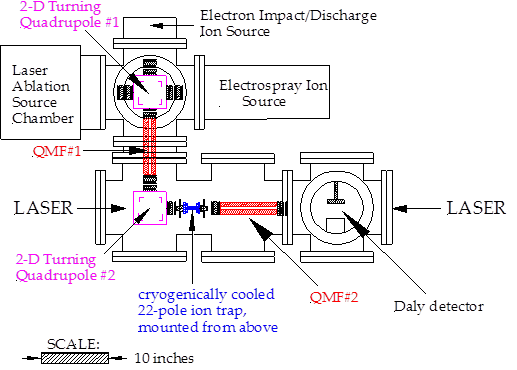Reports: ND655183-ND6: Electronic Spectroscopy of Organic and Organometallic Ions
Michael D. Morse, University of Utah
In this project, we seek to obtain electronic spectra of carbocations, including protonated benzene, alkenyl, dienyl, and trienyl cations, and acylium ions. These species are of interest as important intermediates in petroleum refining and reforming. We also plan to study metal-methane addition adducts such as H-M-CH3+, H2M=CH2+, M=CH2+, MH2+ and related systems in which an oxygen atom is included in the complex. These species are related to catalysts that can activate methane to form more useful products. Construction of our cryo-cooled ion photodissociation spectrometer was begun by my postdoctoral researcher, Sergei Aksyonov, who died unexpected on Sept. 11, 2015. The project was in limbo for about a year following Dr. Aksyonov’s death. Since then, my graduate student, Jason Sorensen, and an undergraduate (now graduated), Erick Tieu, have worked to complete the construction of the instrument. A schematic of the instrument as originally conceived is shown below:
Within the past year, we have discovered that the 22-pole trap is not optimal, because the ions are trapped in off-axis locations, where they are not irradiated by the photodissociation laser. We have designed a new trap based on an axial quadrupole design that will subject the trapped ions to a force that focuses them along the centerline. Our machine shop has nearly completed the construction of this device. We anticipate that this will greatly increase the photodissociation yield of the trapped ions. We are also reworking the electron-impact ionization source, and anticipate that the new design, which incorporates better differential pumping between the ion source and the first quadrupole mass filter (QMF#1) will improve our ion signal substantially. We are also developing an improved laser ablation ion source, which will utilize an ion funnel and hexapole trap to provide preliminary trapping of ions prior to injection into the first quadrupole mass filter. This ion funnel/hexapole trap arrangement will also be employed with other ion sources, including a glow discharge source and an electrospray ion source. This work is providing invaluable training for my graduate student, Jason Sorensen, and for Erick Tieu, a former undergraduate in our department.
With the laser ablation ion source, we expect to produce several orders of magnitude more ions than can be produced with the electron impact source, allowing far greater numbers of ions to be trapped. This will also greatly increase the diversity of species that can be studied as compared to the electron impact ionization source, and will be needed for the studies of metal-methane reaction products.
When these modifications have been incorporated into the instrument, our first targets of study will be generated by electron impact of organic molecules, and will consist of protonated benzene, allyl cation, pentadienyl cation, heptatrienyl cation, and acylium ions. These will be followed by studies of metal ion-methane reaction products using the laser ablation source. We anticipate that completion of this instrument will open up a vast array of molecular ions for study, greatly expanding the scope of the PI’s research.












